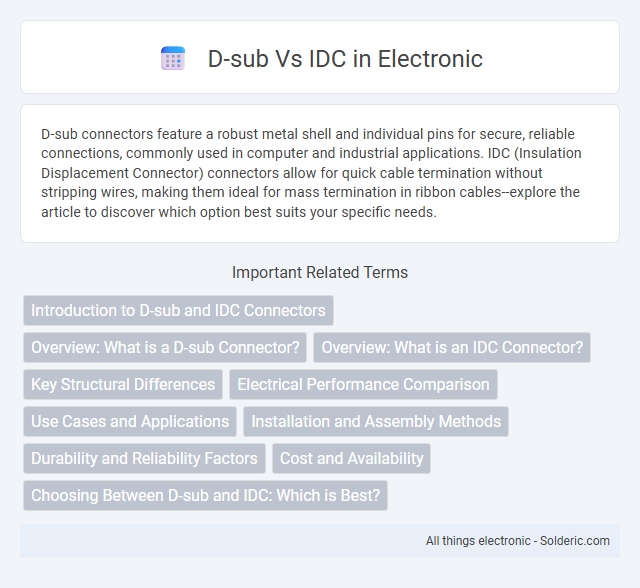D-sub connectors feature a robust metal shell and individual pins for secure, reliable connections, commonly used in computer and industrial applications. IDC (Insulation Displacement Connector) connectors allow for quick cable termination without stripping wires, making them ideal for mass termination in ribbon cables--explore the article to discover which option best suits your specific needs.
Comparison Table
| Feature | D-sub Connector | IDC Connector |
|---|---|---|
| Connector Type | D-subminiature (D-sub) connector with metal shell | Insulation Displacement Connector (IDC) with plastic body |
| Pin Count | Commonly 9, 15, 25, 37, or 50 pins | Varies widely, typically 10 to 50 pins |
| Application | Used in serial ports, video, and peripheral interfaces | Used primarily for ribbon cable connections in internal wiring |
| Connection Method | Soldered or crimped on cable | Press-fit onto ribbon cable without stripping wires |
| Assembly Time | Longer due to soldering/crimping | Faster due to insulation displacement technology |
| Durability | High mechanical strength, metal shell offers shielding | Moderate durability, plastic shell, less mechanical protection |
| Shielding | Typically includes metal shell for EMI protection | Usually no shielding, relies on external measures |
Introduction to D-sub and IDC Connectors
D-sub connectors, known for their D-shaped metal shield, provide secure and reliable connections in computing and telecommunications, accommodating various pin configurations. IDC (Insulation Displacement Connector) technology enables quick and efficient cable terminations without stripping insulation, commonly used in ribbon cables. Choosing between D-sub and IDC connectors depends on your application's need for durability, pin density, and ease of assembly.
Overview: What is a D-sub Connector?
A D-sub connector, short for D-subminiature, is a type of electrical connector featuring a distinctive D-shaped metal shield that ensures secure and reliable connections while preventing misalignment. Commonly used in computer and telecommunications equipment, D-sub connectors accommodate multiple pins in a compact form, supporting both data and signal transmission. Your choice between D-sub and IDC connectors depends on the need for durability, pin density, and ease of assembly in your specific application.
Overview: What is an IDC Connector?
An IDC (Insulation Displacement Connector) is a type of electrical connector designed to quickly and reliably connect wires without the need for stripping insulation. IDC connectors use a sharp metal blade that pierces the insulation and contacts the wire conductor inside, enabling fast mass termination of multiple wires simultaneously. In contrast to traditional D-sub connectors, IDCs are favored for applications requiring high-density, efficient cable termination in telecommunications and data systems.
Key Structural Differences
D-sub connectors feature a metal shell housing individual pins arranged in a trapezoidal shape, providing robust mechanical stability and EMI shielding. IDC (Insulation Displacement Connector) connectors use a plastic housing with evenly spaced contacts designed to pierce insulation directly onto flat ribbon cables. The key structural difference lies in D-sub's pin-and-socket design with metal casing versus IDC's insulation displacement contacts within a plastic body optimized for ribbon cable termination.
Electrical Performance Comparison
D-sub connectors generally offer superior electrical performance with lower contact resistance and better shielding compared to IDC connectors, making them ideal for high-frequency and sensitive signal applications. IDC connectors, while easier and faster to install, often introduce higher contact resistance and potential signal integrity issues due to their insulation displacement method. Understanding these differences helps you choose the right connector based on the electrical requirements of your project.
Use Cases and Applications
D-sub connectors excel in high-reliability industrial and military applications requiring secure, rugged connections with multiple pins for data, audio, or video signals. IDC connectors are favored in mass termination scenarios, ideal for quickly connecting ribbon cables in computer peripherals, telecommunications, and consumer electronics where ease of assembly and cost-effectiveness are critical. You benefit from choosing D-sub for durability in harsh environments, while IDC suits streamlined production and space-constrained designs.
Installation and Assembly Methods
D-sub connectors feature solder or crimp terminations requiring precise manual or automated soldering and cable preparation, ensuring robust electrical connections but needing more assembly time. IDC connectors utilize insulation displacement technology, allowing wires to be pressed directly into contacts without stripping, significantly speeding up installation and reducing labor costs. Your choice depends on the balance between assembly speed, reliability, and the specific application's wiring complexity.
Durability and Reliability Factors
D-sub connectors offer superior durability with robust metal housings that protect against physical damage and electromagnetic interference, making them ideal for applications requiring long-term reliability. IDC connectors, while easier to assemble and cost-effective, generally provide lower durability due to their plastic housing and mechanical connection, which can degrade under repeated stress or environmental factors. Your choice should consider the operational environment, as D-sub connectors maintain consistent performance in harsh conditions, whereas IDC connectors are better suited for less demanding, short-term use.
Cost and Availability
D-sub connectors typically have higher costs due to their robust metal housing and complex assembly, often making them less affordable for large-scale projects. IDC connectors offer more cost-effective solutions with simpler, mass-produced plastic design and quick insulation displacement termination, ensuring widespread availability. When considering your project budget and sourcing, IDC connectors generally provide better cost efficiency and easier procurement.
Choosing Between D-sub and IDC: Which is Best?
Choosing between D-sub and IDC connectors depends on application needs such as signal type, durability, and installation ease. D-sub connectors offer robust metal shells and reliable connections ideal for high-frequency data or video transmission, while IDC connectors enable quick, tool-free assembly for ribbon cables in compact electronic devices. Evaluating factors like connection environment, cable type, and maintenance frequency helps determine the optimal choice for system reliability and performance.
D-sub vs IDC Infographic

 solderic.com
solderic.com